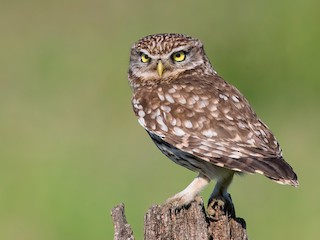Ancient Greece - 440-404 BCE Attica, Athens Owl AR Tetradrachm NGC MS
The obverse of Athena's image is a blend of beauty and intimidation, with her femininity literally topped off with a military helmet. A similar theme is found upon the United States Type 2 Standing Liberty quarters of 1917-1930.
Athene noctua, the Little Owl, which today can be found in Europe and Asia.
The species of owl found on the coin's reverse has been identified as the Athene noctua, the Little Owl, which is native to the Mediterranean sea area. Such creatures stand six to eight inches tall, and weigh between 2.5 and 4.5 ounces. The olive sprig, which refers to Athens' primary export of olive oil, ironically serves as a symbol of peace upon a coin that was used to fund wars. The initials 'AOE' stand for 'AOENAION'--"of the Athenians."
The Tetradrachm was used to pay for building projects, large commercial transactions, international trade, and preparation for war. By carefully controlling size, weight, and fineness, Greek Tetradrachms became known as a consistent, reliable, and trusted monetary unit, resulting in regional and global acceptance. This piece was struck during the time of the Peloponnesian War (431-404 BC) between Athens and Sparta and was used to pay for war-related goods or services.
| Grading Service | NONE |
|---|---|
| Year of Issue | NONE |
| Grade | NONE |
| Ancient Year Range | 5th-4th C. BC |
| Denom Type | N/A |
| Numeric Denomination | AR Tetradrachm |
| Mint Location | NONE |
| Designation | NONE |
| Circ/UnCirc | Not Specified |
| Strike Type | N/A |
| Holder Variety | Strike 5/5; Surface 4/5, nearly Full Crest |
| Grade Add On | NONE |
| Holder Type | N/A |




